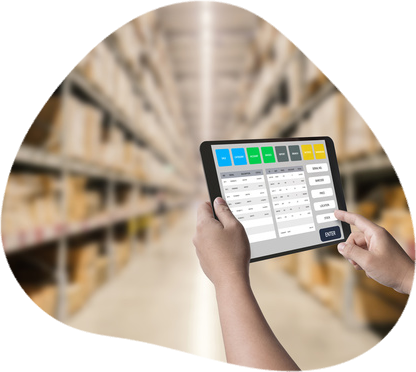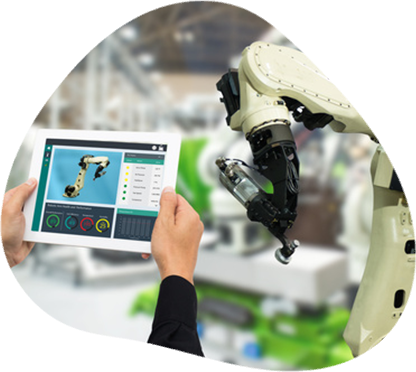iDACS connects industrial plants, manufacturing operations, and enterprise levels of organizations for greater business outcomes; via nine industrial applications.
An IoT based ERP/ Machine agnostic system from MSID with real time data acquisition & production monitoring capabilities. iDACS enables 4M control across shop floor through smart decision enabling insights to stakeholders.
Platform

Computerized Mfg
Control System (CMCS)
For remote monitoring, control, and visualization
Asset Performance
Management (APM)
For increasing site availability, reliability, performance, and safety
Service
For increase in asset uptime, asset utilization, and customer delight
Manufacturing Execution
System (MES)
For optimizing production processes, products, quality and traceability
Sequencing
For achieving customer (including OEM) JIT, JIS, and other sequencing demands
Warehouse Management
System (WMS)
For real-time inventory control, record integrity, labor efficiency, and digital ASN
Logistics Tracking
For inbound, internal, and outbound inventory movement tracking, management, and control
Digital Twin
For optimizing existing/upcoming assets and processes via digital prototypes
Manufacturing Intelligence
For tracking and achieving organization-wide KPI targets in real-time

Computerized Mfg Control System (CMCS)
CMCS connects humans to machines in a user-friendly way for remote and intelligent monitor, control, and visualization of plant/factory equipment and operations.
Plant/factory operators are able to monitor, control, optimize, and resolve alarms and alerts in a quick and prioritized manner from anywhere, anytime, and using any device.
Benefits include:
Reduce Downtime
Provides visualization and control for each machine at multiple industrial sites. Thus, operators monitor, control, resolve alarms and incidents, and place maintenance and repair service orders that maximize equipment availability, uptime, and utilization.
Reduce Risks
Via real-time dashboards, operators have a personalized and informed view of issues and tasks for faster resolution and less errors, incidents, EH&S, and security risks. This strengthens the assets in place to help mitigate additional challenges.
Increase Efficiencies
Operations run more efficiently when operators have step-by-step electronic instructions to guide the correct actions at ideal times. Operators can prioritize MES and CMCS alarms to efficiently delegate and to take optimal actions.
Faster Alarm Resolution
Quickly provides insights at a glance from anywhere, anytime, and from any device via visualization. Thus, operators quickly detect and respond to issues and prioritize and resolve alarms efficiently to reduce costs and maximize profitability.

Asset Performance Management
Asset performance management maximizes the utilization, reliability, performance, and safety of industrial sites on a global basis. Asset health monitoring and predictive maintenance minimize costly equipment failures or unplanned downtime.
This results in cost reductions from maintenance, emergency repairs, and spare part inventory levels. It also results in revenue growth from lost sales and customer dissatisfaction reductions.
Asset integrity inspections, regulatory compliance, and safety risk calculations help plant or machine operators reduce EH&S incidents.
Benefits include:
Increase Asset Utilization
Monitor components, assets, and systems at multiple industrial sites to protect from failure, security, and safety threats; to reduce unplanned downtime and to increase availability, utilization, throughput, and reliability.
Prioritize Maintenance
Optimize workforce productivity, equipment health, and performance by prioritizing maintenance based on condition, criticality, and cost; instead of age, use, or schedules.
Predict Maintenance
Utilize predictive maintenance to minimize costly emergency repairs by detecting issues early and transforming unplanned downtime into planned or scheduled downtime.
Reduce Risks
Utilize best-in-class strategies to protect employee health, safety, the environment, and compliance; while minimizing security and product quality risks due to unplanned downtime.

Service and Support
The service and support industrial application helps dispatchers better schedule and dispatch service work orders. They also ensure technicians have the required context, instructions, and service information for quick issue resolution onsite or remotely.
It also increases technician utilization and daily productivity via mobile and social applications.
Finally, the application strengthens customer delight and increase equipment availability and utilization via predictive and preventive maintenance.
Benefits include:
Increase Asset Uptime
Maximize equipment availability, uptime, reliability, and utilization via predictive monitoring and maintenance, repair time reductions, and higher first-time fix rates.
Decrease Service Costs
Reduce service costs by automatic service requests including maintenance to minimize equipment failure, remote issue resolution, and higher first-time fix rates.
Decrease Repair Time
Reduce repair time with faster skilled technician dispatch and technicians equipped with customer, equipment, part, and repair instructions data for greater productivity.
Increase Service Revenue
Increase service revenue by using equipment health data, alerts, and maintenance execution to offer new proactive service models based on maximum uptime SLAs and/or provide access to data and insights for a fee.

Manufacturing Execution System
Overview
Manufacturing execution system (MES) industrial application is part of manufacturing operations management (MOM). It serves as a gateway between industrial site automation and enterprise/business operations. I.e., the shop floor to top floor.
Data Acquisition
The MES data acquisition module connects with various enterprise systems (ERP, PLM, QMS) and equipment such as machines, robots, RFID readers, sensors, and automation controllers. Automated interfaces of historians are used to collect data from PLCs, SCADA, and other sources.
Track and Trace
Machine data and RFID/barcode scans automate track and trace genealogy for the 4Ms (machine, method, manpower, and material) through the entire production cycle. Results and genealogical data for each inbound logistics, production, packaging, warehouse, and shipping step are monitored and recorded to provide full material and part traceability. Thus, root cause analyses and inspections are possible for customer rejections and product recalls.
Overall Equipment Effectiveness (OEE)
Machine data are also monitored and analyzed in real-time on edge and enterprise servers. From this data, machine running status and production count or productivity/performance are measured. Planned and unplanned downtime are calculated to determine equipment availability. Finally, quality is determined from reject rates and KPIs such as OEE are provided.
Machine Health
Data acquisition also enables alerts and event management. For instance, machine health can be monitored and alerts sent out for preventive/predictive maintenance and equipment failures.
4Ms (Machine, Material, Method, & Manpower)
MES also optimizes manufacturing processes to consistently meet production targets in agile environments, maximizes product quality, and minimizes risks. This is accomplished via various manpower, material, machine, and method controls.
Manpower Controls
Manpower planning or controls determine the number of operators per machine, operators with appropriate skillset, and authorized operators before machines can run. Also, a user guidance system module is used for workflows and to guide operators during production, assembly, and/or recipe management. It contains information and instructions in various formats for manufacturing materials and products.
Material Controls
Material controls are in place and consist of three phases. The first phase is to verify the materials received via 3-way matching, part number, quantity, lot number, and expiration date. Then barcode/RFID labels are applied and materials are sent to quality inspection.
During the second phase, quality is measured via full, random, sample, or skip lot testing and inspections. Once materials pass quality, they are ready to be sent to plant warehouses, production floor, or production machines.
During the final or third phase, certain parameters (such as FIFO, LIFO, expiration date, etcetera) have to be met before material moves to production.
Machine Controls
Machine controls require ERP work orders, production schedules, and appropriate operators and material before equipment can function. Before full production runs, samples at various time intervals have to be tested and approved.
Method Controls
Method controls via production control system minimize over- and under production. Once certain production quantity is met, production halts.
Routing or sequence controls ensure all sequences are consistently followed or production stops.
Control chart parameters (such as temperature, pressure, and leaks) and procedures are captured and monitored by quality. Alerts can be triggered and production halted to reduce product defects and non-compliance.
Finally, production can be controlled by means of KANBAN, production orders, and sequencing orders. Thus, various WIP materials and components are delivered in sequence to production stations when needed.
Warehouse
Inbound and outbound logistics are synchronized to production via the warehouse module for various types of production methodologies like KANBAN, production orders, and sequencing. Materials at various WIP stages are efficiently delivered to the appropriate production stations; for multiple production lines in the correct sequence. Finished goods are either dispatched for delivery, packed and stored, or repacked and dispatched to consistently meet customer service levels.
Benefits include:
Reduce Production Costs
Utilize 4M controls, inspections, and regulatory and customer specifications compliance to reduce production errors, waste, rework, labor, energy, inventory, downtime, EHS, and product recall costs.
Improve Product Quality
To reduce reject rates; use 4M controls, error proofing, parameter capture, and traceability to identify and reduce non-conforming, out of specifications, and defective materials/ products.
Increase Production Output
Increase performance, productivity, quality, compliance, and production capacity by monitoring/optimizing 4Ms to maximize equipment availability, hourly throughput, on-time deliveries, and service levels adherence.
Reduce Downtime
Reduce unplanned downtime by tracking/optimizing inventory (to minimize stock-outs), machine health, manpower, and production/logistics processes.

Sequencing
Just in Time (JIT) manufacturing and Just in Sequence (JIS) assembly and shipping help enterprises increase operational efficiency and reduce supply chain complexity. Production and warehouse operations are synchronized to multiple customers’ (including OEMs) pull signals. Materials and WIP are delivered to production stations when required and in sequence of assembly at multiple production lines. Finished goods are shipped to sequence per agreed upon schedules. Finally, all relevant, sequenced manufacturing and warehouse actions are validated via RFID or barcode scans.
Real-time monitoring, alerts, signals, and KPIs for JIT and JIS empower manufacturers to:
- Maximize capacity utilization, throughput, first-time right quality, and profitability.
- Accelerate time to market and increase customer delight.
- Increase flexibility via real-time schedule adjustments in response to abrupt production shifts from unplanned events, strategy shifts, and market changes.
Benefits include:
Improve Production Control
Stop all production requirements miscommunication, wrong dispatches, and production delays.
Reduce Customer Penalties
Reduce huge penalties from customers due to wrong dispatches (from not adhering to sequences) and to production and delivery delays.
Improve Performance
Automate all manual sequence downloads and manual sequence instructions to increase production and delivery performance/efficiency.
Reduce Working Capital
Reduce inventory levels, inventory carrying cost, and idle inventory.

Warehouse Management System (WMS)
Enterprises pursue perfect material, information, and financial flows like zero defects and perfect quality. However, differences exist between physical inventory on hand (POH) and electronic inventory records on hand (ROH). POH>ROH leads to excess physical inventory not accounted for within facilities by supply chain systems such as WMS. This results in inventory that cannot be sold, used for customer demand, obsolescence, and write-offs. ROH>POH results in materials or products sold to customers or scheduled for production when they do not exist. This leads to stock-outs, backorders, lost sales, and dissatisfied customers.
With the use of real-time information from a WMS; material, information, and financial flows are improved. Inventory control for record integrity is also improved to reduce the differences between POH and ROH and the corresponding issues mentioned above.
Warehouse labor management is also a concern for enterprises due to high labor costs and shortage of available talent. Within a warehouse, typically the most expensive activity is order picking. It can also be the most labor-intensive activity with an average order picker walking several miles a day. To reduce labor costs and the number of pickers; a WMS’ pick to light or voice-guided system can be utilized. Unlike a voice-guided system, a pick to light system does not require any language requirements. This helps organizations expand its labor pool, use less-skilled labor, and hire temporary workers with limited training during peak seasons.
For a pick to light system, operators work in zones. Once an order is delivered to warehouse, a label is attached to a container or tote. An operator will scan the tote and the lights will turn on to specify the quantity to pick from the bin. To confirm the pick, the operator will press the lighted indicator. If the pick is accurate, the lights will turn off. Next, the operator will go to the next bin and follow the same process until all the items in his or her zone are picked.
Real-time monitoring, visibility, and updates for relevant warehouse tasks and actions ensure the right material at the right time is delivered either to production or customers. To increase customer delight, digital notifications can be sent for when out-of-stock items are back in stock. Also, digital advanced shipping notices (ASNs) are sent for shipments and returns. These notifications improve order visibility, boost efficiency, and increase trust.
Benefits include:
Improve Material Control
Monitor and control material receipt in real-time until shipment out of warehouse. Controls issuance on FIFO logic, validates expiration dates, and verifies both production and customer orders; to reduce inventory shrinkage, obsolescence, and returns.
Improve Performance
Light guided systems support untrained operators to pick materials efficiently and use shortest path AI algorithms to reduce motion or walking waste. This accelerates operator picking performance and reduces the risk of wrong picks and deliveries.
Improve Visibility
Account for all inventory in a warehouse and know exactly where each item is located. This minimizes the differences between actual and digital inventory. It also allows for ABC analyses, fast/slow moving material visibility, and identification of obsolete inventory.
Increase Compliance
Cater to all statutory and customer requirements by generating ASNs as soon as dispatch processes are completed. This will automate manual operations, reduce delays, improve order visibility, and increase customer satisfaction.
Logistics Tracking
Logistics management and tracking provide real-time visibility for material, WIP, and finished goods inventory involved in order fulfillment. Inventory is tracked from suppliers, internal transfers, and within facilities. Finished goods are also tracked to end consumers up to spatial or street level.
Barcodes, RFIDs (passive and active), bluetooth beacons, GPS via LTE, GPS via satellite, and sensors are used to collect real-time information. Parameters such as date, time, status, condition, expiration, location, geofence, movement, and etcetera are also tracked in real-time. For instance, raw materials, WIP, and finished goods are tracked in transit to identify items that are stationary, off route, and their estimated delivery times.
Inbound material tracking from suppliers allows enterprises to measure on-time performance and other supplier performance metrics. It also allows organizations to make adjustments for longer than expected lead-times and material unavailability; before downstream operations are negatively impacted.
For internal, priority material transfers and movement of materials within facilities; zonal tracking locates their exact location to reduce time finding them.
For finished goods shipments; location, delivery status, and operating conditions such as temperature, humidity, vibration, and shock can be tracked in real-time. Thus, finished goods' delivery time, quality, and condition are used to determine if customer requirements are met.
Benefits include:
Improve Material Movement
Rule-based material issuance and visibility for procurement and internal transfers to control, improve material flow, and reduce inventory.
Reduce Downtime
Real-time tracking of materials to reduce downstream downtime due to material unavailability or late arrivals.
Increase Shipment Visibility
Real-time tracking of finished goods shipments for on-time deliveries of items that meet customers’ quality and condition specifications.
Reduce Cost
Reduce logistic inefficiencies, shrinkage, obsolescence, fraud, theft, and damage via real-time monitoring.

Digital Twin
Digital twin is a digital replica of physical industrial processes, components, assets, and complete systems. The twin can also serve as a prototype before a process, component, asset, and complete system is built.
The digital twin functions as a computing resource to collect real-time data from sensors on physical objects. Cognitive computing is used to understand context, optimize performance via simulations, predict future behavior, and drive significant business outcomes.
Benefits include:
Reduce Asset Downtime
Unscheduled outages and failures may take place when it is difficult to determine accurate maintenance schedules using mean time between failure and other estimates. Thus, a digital twin can be used to accurately predict maintenance intervals to reduce unplanned outages and downtime.
Reduce Maintenance Costs
A digital twin can use predictive analytics to model, analyze, and run simulations for virtual asset health and more accurate maintenance schedules. Likewise, maintenance can be conducted on condition or health instead of age, time, or routine intervals; reducing unnecessary maintenance costs.
Reduce Asset Defects
A digital twin can be used to innovate, improve design, and reduce defects for existing and future equipment. A digital replica can be built and multiple tests, simulations, and analyses conducted for new insights; without disrupting current operations.
Increase Time to Value
A digital twin generates faster value realization through “unlimited” experimentation in safe environments. This results in benefits which include improvement for equipment uptime, production yield, market agility, asset design, cycle times, and factory efficiency.

Manufacturing Intelligence
The operations/manufacturing intelligence industrial application enables smarter decision making from the plant to enterprise level.
It provides information and insights for maximizing industrial sites’ revenue and profit. Key business and operational KPI projections are established. They are tracked and monitored in real-time versus actuals. Proactive actions are taken in real-time to address deviations and to drive continuous improvements.
Centralized benchmarking for throughput, production plans, loss analysis, and other KPIs within, between, and across plant sites are made. Scenarios and what-if analyses via digital twins are used to further optimize process, production performance, and business outcomes.
Benefits include:
Improve Product Quality
Monitors error-proofing and quality inspection processes to proactively send alerts when quality drops and to recommend process changes.
Increase Operations Speed
Streamlines, optimizes, and accelerates production throughput and other MES processes across multiple industrial sites.
Improve Asset Utilization
Improves the processes and outcomes supported by application performance and service management to increase asset uptime.
Reduce Business Risk
Relevant processes are monitored and improved to reduce EH&S, cyber, labor, and supplier risks.
